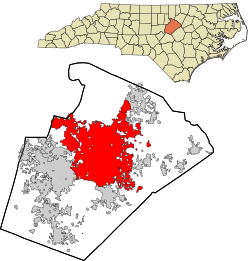Raleigh, North Carolina
Raleigh (pronounced /ˈrɔːli/, RALL-lee[5]) is the capital and the 2nd most populous city in the U.S. state of North Carolina as well as the county seat of Wake County. Raleigh is known as the "City of Oaks" for its many oak trees.[6] The area is also nicknamed "The Triangle".
| City of Raleigh | |
 | |
|
| |
 Location in Wake County and the state of North Carolina. | |
| Coordinates: 35°46′N 78°38′W / 35.767°N 78.633°WCoordinates: 35°46′N 78°38′W / 35.767°N 78.633°W[1] | |
| Country | |
| State | |
| Counties | Wake, Durham |
| Chartered | December 31, 1792 |
| Named for | Sir Walter Raleigh |
| Government | |
| • Type | Council–Manager |
| • Mayor | Mary-Ann Baldwin (D) |
| • Council | Members
|
| Area | |
| • State capital city | 147.64 sq mi (382.38 km2) |
| • Land | 146.54 sq mi (379.55 km2) |
| • Water | 1.09 sq mi (2.83 km2) |
| Elevation | 315 ft (96 m) |
| Population (2010) | |
| • State capital city | 403,892 |
| • Estimate (2019) | 474,069 |
| • Rank | 2nd in North Carolina 41st in United States |
| • Density | 3,234.97/sq mi (1,249.03/km2) |
| • Urban | 1,012,994 |
| • MSA | 1,337,331 (44th) |
| • CSA | 2,201,103 (29th) |
| Time zone | UTC−05:00 (EST) |
| • Summer (DST) | UTC−04:00 (EDT) |
| ZIP Codes | 27601, 27603, 27604, 27605, 27606, 27607, 27608, 27609, 27610, 27612, 27613, 27614, 27615, 27616, 27617 |
| FIPS code | 37-55000[4] |
| GNIS feature ID | 1024242[1] |
| Major airport | Raleigh–Durham International Airport |
| Interstate Highways | I-40, I-87, I-440, I-540 |
| Other major highways | US 1, US 64, US 70, US 401, NC 50, NC 540 |
| Rapid Transit | GoRaleigh GoTriangle |
| Website | raleighnc |
Raleigh is part of the Research Triangle area, together with Durham and Chapel Hill. The "Triangle" nickname began after the 1959 plan and construction of the Research Triangle Park, in Durham and Wake Counties. It is in the middle of the three cities and their universities.
The Research Triangle area makes up the U.S. Census Bureau's Raleigh-Durham-Chapel Hill Combined Statistical Area (CSA). It had an estimated population of 2,037,430 in 2013.[7]
History
Raleigh was started in 1770. In 1788, it became North Carolina's state capital. The first state fair happened in 1853 and has kept on happening. Raleigh was not hurt by the Civil War. It did not grow much after the Civil War.
In the early 1900s, Raleigh had streetcars, but they got rid of them later. Raleigh got its first TV station in 1956. In 1959, the Research Triangle Park was built. This caused people to move to the area for the jobs. In the late 1900s, Interstate 40 and Interstate 440 (freeways)were built, helping traffic. Since the late 1900s, Raleigh has grown quickly.
November 28, 1988 tornado
On November 28, 1988, Raleigh was hit by a F4 tornado. The tornado formed after a very warm late November day. A line of thunderstorms that was spotted over the Charlotte area during the afternoon hours hit Raleigh just after 1:00 a.m. ET, however the National Weather Service (NWS) issued no tornado or severe thunderstorm watches for the area. They believed the conditions had not support the right for a tornado. There were two fatalities in the city of Raleigh, and four in total.
2011 tornado
On April 16, 2011, an EF3 tornado struck Raleigh, killing 24 people in North Carolina and four in Raleigh.
Geography
Raleigh is in north-central North Carolina. It is in a hilly area.
Climate
Raleigh has a mild climate. The summers are hot, with an average high of about 90 °F (32 °C). The winters are cool, with an average high of about 50 °F (10 °C). It snows about twice a year with a total of six inches (15 centimeters). Raleigh also gets around 45 inches of rain.
Transportation
Raleigh has a lot of good transportation. Some freeways are Interstate 40, I-440, and I-540. Some highways are U.S. Route 1, 64, and 70, and N.C. highway 50. Raleigh also has a Amtrak station and a big airport.
Other things
Raleigh has a lot of museums. North Carolina State University is also in Raleigh.
Raleigh is pretty rich, but there are some poor areas.[8] The region also has a lot of suburban developments, but there are some crowded areas.
Raleigh, North Carolina Media
North Carolina State Capitol, c.1861; Governor David S. Reid is in the foreground
North Carolina State Treasurers Office in State Capitol, c.1890s
The Raleigh skyline with crepe myrtle trees in bloom 2017
Holy Name of Jesus Cathedral in 2018
Dorton Arena in Raleigh, designed by Matthew Nowicki
References
- ↑ 1.0 1.1 "Raleigh". Geographic Names Information System. United States Geological Survey.
- ↑ "City Council: Raleigh's Governing Body". City of Raleigh. May 6, 2016. Archived from the original on May 6, 2016. Retrieved May 9, 2016.
- ↑ "2019 U.S. Gazetteer Files". United States Census Bureau. Retrieved July 27, 2020.
- ↑ "U.S. Census website". United States Census Bureau. Retrieved January 31, 2008.
- ↑ Wells, John C. (2009). "Ralegh, Raleigh". Longman Pronunciation Dictionary. London: Pearson Longman. ISBN 9781405881180.
- ↑ Population & Census Information. City of Raleigh. http://www.raleighnc.gov/portal/server.pt/gateway/PTARGS_0_2_306_202_0_43/http%3B/pt03/DIG_Web_Content/category/Resident/Raleigh_At_A_Glance/Cat-1C-20051006-152447-Raleigh_Demographics.html. Retrieved 2009-08-21.
- ↑ "Population Estimates 2013 Combined Statistical Areas: April 1, 2010 to July 1, 2013". U.S. Census Bureau. Retrieved March 27, 2014.
- ↑ "Raleigh, North Carolina (NC) profile: population, maps, real estate, averages, homes, statistics, relocation, travel, jobs, hospitals, schools, crime, moving, houses, news, sex offenders". www.city-data.com.

